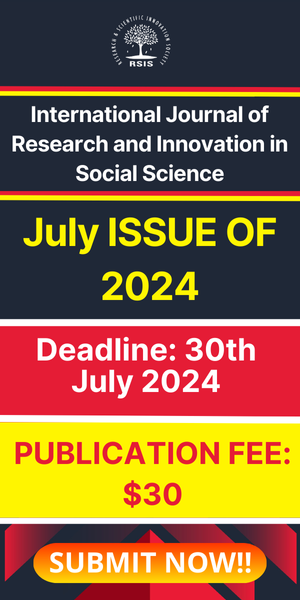Assessment Of Farmers’ Soil Management Practices In Guinea Savannah Agro- Ecological Zone Of Nigeria
- March 21, 2022
- Posted by: rsispostadmin
- Categories: Geography, IJRISS, Social Science
International Journal of Research and Innovation in Social Science (IJRISS) | Volume VI, Issue II, February 2022 | ISSN 2454–6186
Duze Muhammed Kamal Lawal, Dalhatu, Umaru Sangari, and Samaila Kunden Ishaya1
Department of Geography, Nasarawa State University, Keffi, Nigeria.
Abstract – The study assessed farmers’ soil management practices in Karu LGA of Nasarawa State. A total of 112 questionnaires were distributed to farmers’ in the study area to ascertain the prevailing soil management practices and crop yields in the study area. The study reveals that most of the farmers’ in the study area practice tillage soil management practice (107) and zero tillage (102), compost (55) and mono cropping (9) are the least soil management practices in the study area, the correlation analysis shows a positive and significant relationship between crop yield (r = 0.905; p ≤ 0.05) and farmers’ soil management practice. The study therefore, recommends that farmers’ should practice retention of crop residues on the farms especially with respect to guinea corn and maize cropping, also more natural vegetation should be encouraged where trees like Faidherbia albida (apple ring accaia) an ideal agroforestry specie that can grow among field crops without shading them during the wet season can be planted.
Keywords: Farmers’, Soil, Management, Karu
INTRODUCTION
Soil management concerns all operations, practices and treatments used to protect soil and enhance its performance (Oloyede, Muhammed, Ayinde and Omotesho, 2015). They are practices that affect soil quality which includes controlling traffic on soil surface, the use of cover crop and crop rotation, nutrient management and conservation tillage. The goal of soil management is to protect soil and enhance its performance, to farm profitably and preserve environmental quality for decades to come.
This implies, the management of agricultural soils would maintain the soils productivity in an ecologically, economically and culturally sustainable system of soil management. Bationo, Das, and Krenzer, (2004) regarded the strategy that helps low resource farmers mitigate many problems and the characteristics of poverty and food insecurity by improving the quantity and quality of food, income and resilience of soil productive capacity as Integrated Soil Fertility Management (ISFM). This is said to involve the utilization of available organic and inorganic sources of plant nutrients in an efficient manner to improve on nutrient use efficiency by the growing crops.
According to Adeyemo, Oladoja, Famakinwa, and Alabi, (2017), the main issue in the Nigerian agriculture is that of low productivity. The greatest threat to sustaining agricultural productivity in the Nigerian farming communities is the declining productivity of soil caused by the loss of soil fertility through the erosion of top-soil brought about by inappropriate land use practices and the loss of soil water content, soil structure and porosity due to persistent laterisation of the top soil as a result of continuous exposure to sun by man and animals (Alemayehu, Amede, Bohme and Peters, 2013).
This transformation of natural resource not only brings the affected land under nature’s degradation regime but also accelerates the process. Inherent poor fertility of the soil and low use of organic and inorganic fertilizers have been identified as some of the greatest constraints to increasing agricultural productivity in Nigeria. Also with the population growth, demand for land has increased resulting in intense cultivation with little or no fallow periods and the reliance on continuous cropping rather than conservation cropping systems (Assefa & Hans-Rudolf, 2016).
Human activities have either direct or indirect effects on the sustainability of natural resources like land, thereby threatening its continuous productivity (Tesfaye, 2017). This consequently, affects agricultural production. Also, ever increasing population in the developing countries which result in continually rising of demand for agricultural produce is contributing to the intensification of land use and adoption of technologies that would enhance constant supply of agricultural produce (Onwudike, Uzoho, Ihem, Ahukaemere, Nkwopara, Irokwe, and Echeanyanwu, 2016). Attempt by man to meet his food, wood and other resources requirements have destroyed the biodiversity and in order to expand agriculture and forestry, over cropping of some crops has resulted more often, to adoption of appropriate technologies and farm practices which further worsen sustainable land use among farmers (Mauricio, Cassio, and Douglas, 2017). Loss of biodiversity, climate change and land degradation due to population pressure in developing countries, poverty and poor performance of extensive agriculture are such factors that make farmers to have problems in sustainable production activities (Hossen, Mozumder, and Islam, 2013). Soil is therefore managed in order to conserve agricultural land, biodiversity and food security for the country. Sustaining soil fertility and food security cannot be separated. In addition, it is sometimes noted that some farmers have little or no knowledge about soil management, hence they abandon certain farmland when found unproductive due to some factors which can be controlled provided they are well equipped with knowledge on soil fertility.


